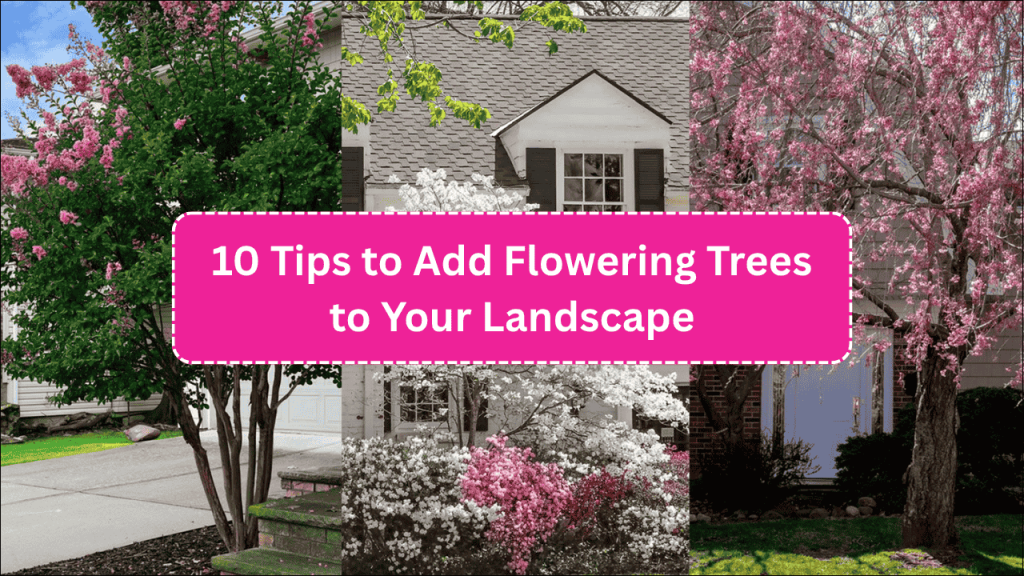
Transform your outdoor space into a vibrant, living masterpiece with strategically placed flowering trees that provide year-round beauty, wildlife habitat, and increased property value. These magnificent specimens serve as living sculptures that evolve through seasons, offering spectacular blooms, fragrant air, and natural shade while creating focal points that define and enhance your landscape’s character.
Overview: Essential Flowering Tree Categories
| Tree Type | Bloom Season | Height Range | Sunlight Needs | Popular Varieties |
|---|---|---|---|---|
| Spring Bloomers | March-May | 15-40 feet | Full sun to partial shade | Cherry, Magnolia, Dogwood, Redbud |
| Summer Bloomers | June-August | 20-50 feet | Full sun preferred | Crape Myrtle, Jacaranda, Mimosa |
| Fall Bloomers | September-November | 10-30 feet | Full sun to partial shade | Autumn Cherry, Sweet Osmanthus |
| Evergreen Bloomers | Year-round/Seasonal | 8-25 feet | Varies by species | Camellia, Rhododendron, Bottlebrush |
| Fragrant Varieties | Spring/Summer | 12-35 feet | Full sun to partial shade | Lilac, Mock Orange, Sweet Bay |
Tip 1: Consider Your Climate Zone and Soil Conditions
Understanding your hardiness zone is fundamental to successful flowering tree cultivation. Different species thrive in specific temperature ranges and soil conditions, making local climate adaptation crucial for long-term success.
Research trees native to your region or those proven to adapt well to local conditions. Native species typically require less maintenance, show greater disease resistance, and provide better habitat for local wildlife. Conduct soil tests to determine pH levels, drainage capacity, and nutrient content, as these factors significantly influence tree health and flowering potential.
Tip 2: Plan for Succession Blooming
Create continuous color throughout the growing season by selecting trees with staggered bloom times. Early spring bloomers like forsythia and cherry trees can be followed by summer-flowering crape myrtles and fall-blooming varieties for extended visual interest.
Design your landscape to feature something in bloom from early spring through late fall. This strategic planning ensures your garden maintains appeal and provides ongoing pollinator support throughout the growing season.
Tip 3: Strategic Placement for Maximum Impact
| Placement Strategy | Purpose | Best Tree Types | Spacing Guidelines |
|---|---|---|---|
| Focal Point | Create visual anchor | Large magnolias, flowering cherries | Center of view, 25-30 feet from structures |
| Property Boundary | Privacy and definition | Tall crape myrtles, flowering plums | 15-20 feet apart along borders |
| Entrance Enhancement | Welcome appeal | Compact redbuds, ornamental pears | 12-15 feet from walkways |
| Window Views | Indoor enjoyment | Dogwoods, flowering crabapples | 20-25 feet from windows |
| Patio Shading | Functional beauty | Japanese maples, silk trees | 15-20 feet from seating areas |
Position flowering trees where they can be appreciated from both indoor and outdoor vantage points. Consider sight lines from windows, patios, and main walkways to maximize visual impact and daily enjoyment.
Tip 4: Size Matters – Choose Appropriate Mature Dimensions
Avoid common landscaping mistakes by researching mature tree dimensions before planting. Small spaces require compact varieties, while large properties can accommodate specimen trees that reach impressive heights and spreads.
Consider both current space limitations and future growth potential. Factor in proximity to power lines, structures, and other plantings to prevent overcrowding and maintenance issues as trees mature.
Tip 5: Complement Existing Landscape Elements
Integrate flowering trees harmoniously with existing plantings, architectural features, and landscape design themes. Consider color coordination with permanent structures, seasonal plants, and established trees to create cohesive visual flow.
Choose species that complement rather than compete with existing focal points. Use flowering trees to enhance existing garden features or create new areas of interest that work within your overall landscape vision.
Tip 6: Maintenance Requirements and Long-term Care
| Maintenance Level | Tree Examples | Annual Requirements | Special Considerations |
|---|---|---|---|
| Low Maintenance | Dogwood, Redbud, Serviceberry | Minimal pruning, annual mulching | Drought tolerant once established |
| Moderate Maintenance | Crape Myrtle, Flowering Cherry | Regular pruning, fertilizing | Pest monitoring, disease prevention |
| High Maintenance | Magnolia, Japanese Maple | Frequent pruning, pest control | Specific soil requirements, protection |
Select trees that match your available time and expertise for ongoing care. Low-maintenance varieties suit busy homeowners, while gardening enthusiasts might enjoy the challenge of more demanding species.
Tip 7: Wildlife and Pollinator Benefits
Choose flowering trees that support local ecosystems by providing nectar, pollen, and habitat for beneficial insects, birds, and other wildlife. Native flowering trees typically offer the greatest ecological benefits while requiring minimal intervention.
Consider bloom timing relative to local pollinator activity periods. Early spring bloomers provide crucial nectar sources when few other plants are flowering, while summer varieties support peak pollinator populations.
Tip 8: Multi-Season Interest Beyond Blooms
Select trees offering year-round appeal through varied characteristics like colorful fall foliage, interesting bark patterns, attractive fruit, or distinctive branching structures. This approach maximizes landscape value and visual interest throughout all seasons.
Trees with multiple attractive features provide better long-term investment value and sustained landscape appeal even when not in bloom.
Tip 9: Proper Planting Techniques and Timing
| Planting Season | Advantages | Best Practices | Considerations |
|---|---|---|---|
| Early Spring | Active growth period | Plant after frost danger | Adequate water availability |
| Fall | Root establishment | 6-8 weeks before hard frost | Reduced transplant stress |
| Late Winter | Dormant season planting | Bare root planting possible | Weather-dependent timing |
Plant during optimal seasons to ensure establishment success. Proper planting depth, adequate spacing, and initial watering establish strong foundation for healthy growth and abundant flowering.
Tip 10: Budget-Friendly Approaches and Long-term Investment
Consider various purchasing options including nursery specimens, online retailers, plant swaps, and community tree programs. Smaller trees cost less initially and often establish more successfully than large specimens.
View flowering trees as long-term investments that increase property value, reduce energy costs through strategic shading, and provide decades of enjoyment with proper selection and care.
Seasonal Care Calendar
Spring: Fertilize, prune dead wood, monitor for pest emergence, apply fresh mulch Summer: Deep watering during drought, pest management, deadheading spent blooms Fall: Rake and dispose of diseased leaves, plant new specimens, winter preparation Winter: Dormant season pruning, planning future additions, protection from harsh weather
Common Mistakes to Avoid
Avoid planting too close to structures, selecting inappropriate sizes for available space, neglecting soil preparation, and choosing varieties unsuited to local climate conditions. Research thoroughly before purchasing and planting to prevent costly mistakes and disappointment.
Conclusion: Creating Your Flowering Tree Paradise
Successfully incorporating flowering trees into your landscape requires thoughtful planning, appropriate selection, and committed care. These living investments reward homeowners with seasonal beauty, environmental benefits, and enhanced property value for generations.
Start with one or two well-chosen specimens and gradually expand your flowering tree collection as you gain experience and confidence. Each tree planted today becomes tomorrow’s legacy, providing beauty and benefits that extend far beyond the initial investment.
Frequently Asked Questions (FAQs)
Q1: When is the best time to plant flowering trees? A: Early spring or fall are optimal planting times, allowing trees to establish roots before extreme weather conditions.
Q2: How far should flowering trees be planted from my house? A: Plant trees at least 15-20 feet from structures, considering the mature spread to prevent foundation and roof damage.
Q3: Do flowering trees require special fertilizer? A: Most flowering trees benefit from balanced fertilizer in early spring, but specific needs vary by species and soil conditions.
Q4: How long does it take for newly planted flowering trees to bloom? A: Most flowering trees begin blooming 2-4 years after planting, with full flowering potential reached in 5-7 years.
Q5: Can flowering trees survive in partial shade? A: Many varieties tolerate partial shade, though full sun typically produces more abundant blooms and stronger growth.













